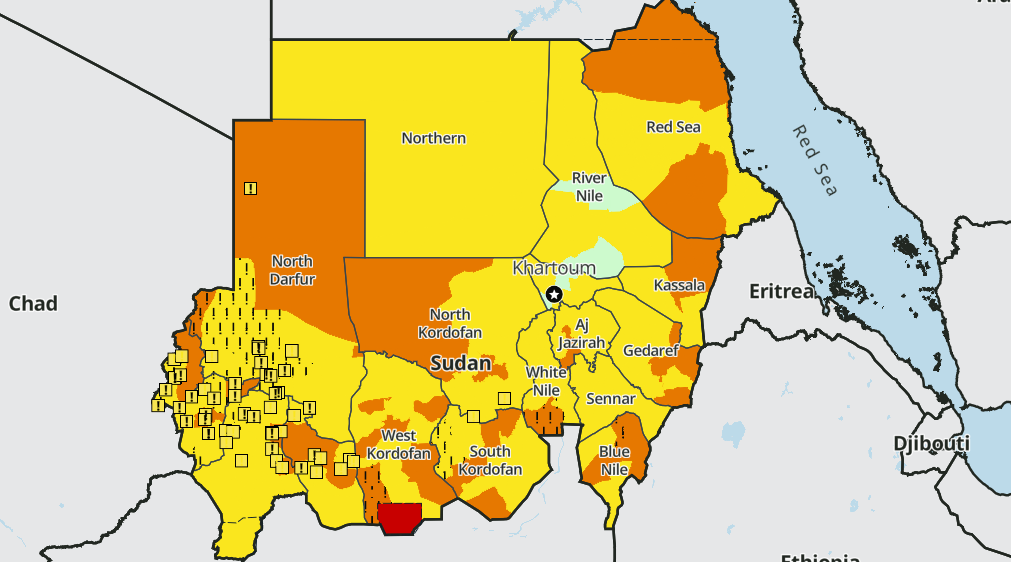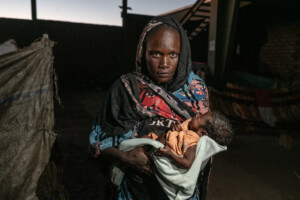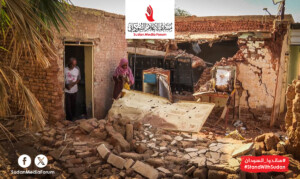FEWS NET: Millions of Sudanese face critical shortages of food and water

Sudan Acute Food Insecurity, April-May 2023 projected outcomes (FEWS NET)
WASHINGTON D.C. –
The fierce fighting between the Sudanese army and the paramilitary Rapid Support Forces (RSF) that erupted in Khartoum and various other places in the country on April 15 has led to a rapid deterioration in food security conditions, the Famine Early Warning Systems Network (FEWS NET) reported on Friday.
The war ongoing conflict that erupted on April 15 following the breakdown of security sector reform negotiations between the Commander-in-Chief of the Sudanese army, Lt Gen Abdelfattah El Burhan and the leader of the paramilitary Rapid Support Forces (RSF), Mohamed ‘Hemedti’ Dagalo has caused a “swift and unanticipated disruption to trade and market functionality, household mobility, humanitarian assistance, and basic service provision,” FEWS NET* states.
The armed conflict has left millions of people facing critical shortages of food, water, and basic supplies, particularly in dense urban areas and in greater Darfur which hosts a large share of displaced and acutely food insecure people.
As a near-term resolution to the conflict is “highly unlikely”, the US monitoring team foresees “a sharp, rapid increase” in the population facing Crisis and Emergency outcomes, with the largest increases anticipated in densely populated urban areas such as Khartoum and the greater Darfur region.
“Before the outbreak of conflict, Sudan already faced a high burden of food insecurity given the exceedingly high cost of living amidst the persistence of poor macroeconomic conditions and intercommunal conflict,” the report reads.
“While the current fighting has not yet spread to rural areas, the likely ripple effects of trade disruptions and price increases in rural areas – particularly at a time when food stocks are already declining and market dependence is increasing – are expected to further exacerbate food consumption gaps and cause an increase in Crisis (IPC Phase 3) outcomes across the country as it heads into the typical lean season period from June to September.
“Emergency (IPC Phase 4) outcomes are likely to increase among populations that are already acutely food insecure and have low coping capacity, rendering them highly vulnerable to the direct and indirect impacts of the ongoing conflict on food security conditions.”
Supplies dwindle
The humanitarian situation continues to deteriorate, and the healthcare system has been severely affected by the fighting. The treatment of approximately 50,000 acutely malnourished children has been disrupted by the conflict.
“Power outages have impacted the cold storage of pharmaceutical and medical supplies, leading to critical shortages and damaging vaccine stocks. Combined with a lack of access to clean drinking water, the risk of disease spread and implications for malnutrition is highly concerning,” FEWS NET reported.
“In addition, a recent report from the World Health Organization indicates a high risk of biological hazard as a laboratory was seized in Khartoum, with workers unable to gain access and power cuts threatening the management of its materials.
“In Khartoum and surrounding areas, a few markets are sporadically open, but prices have skyrocketed as supply dwindles and demand spikes amidst household depletion of food, water, and essential items. At the same time, household ability to purchase is increasingly undermined by lack of access to their bank and mobile money accounts.”
In El Geneina, capital of West Darfur, reports of market destruction and widespread looting similarly point to likely reductions in food supply and access.
Displaced, refugees
The suspension of humanitarian assistance by WFP and humanitarian partners continues as the threat to the lives of staff remains elevated under current conditions, and humanitarian facilities have reportedly been looted.
Food assistance in Sudan has typically prioritised displaced people, refugees, and seasonally food insecure populations throughout the country and is usually scaled up during the lean season.
In its absence, the 3.7 million internally displaced population — which includes an estimated three million people in the Darfur region alone, plus more than 75,000 recently displaced — and the most food-insecure households in rural areas are likely facing a sharp increase in the severity of their food consumption gaps.
Tens of thousands of the estimated 1.3 million refugees hosted within Sudan are being newly displaced, with an estimated 33,000 fleeing Khartoum to neighbouring states within Sudan and 10,000 South Sudanese refugees returning to South Sudan, the FEWS NET report said.
An estimated 20,000 Sudanese have crossed into Chad, but estimates of arrivals into Egypt, Central African Republic, and Ethiopia are currently unknown.
* The United States Agency for International Development (USAID) established the Famine Early Warning Systems Network (FEWS NET) in 1985 in response to devastating famines in East and West Africa and a critical need for better and earlier warning of potential food security crises. Analysts in 20 field offices work with US government science agencies, national government ministries, international agencies, and NGOs to produce forward-looking reports on more than 35 of the world’s most food-insecure countries.











 and then
and then